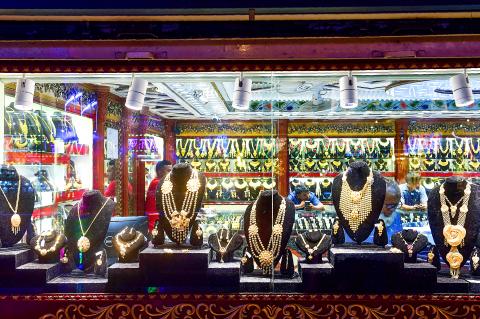India, which vies with China as the top consumer of bullion, is working on new policies to improve transparency and help expand its US$19 billion gold jewelry industry, according to people with knowledge of the matter.
The plans being worked out by India’s finance and commerce ministries along with industry groups should be finalized by the end of March next year, the people said, asking not to be identified because they are not authorized to speak publicly.
Indian Ministry of Finance spokesman D.S. Malik did not answer calls to his cellphone, while a spokeswoman for the Indian Ministry of Commerce did not reply to an e-mail seeking comment.

Photo: AFP
The start of a spot bullion exchange, to make gold supply more transparent and help enforce purity standards is under consideration, the people said.
An import tax of 10 percent could also be reduced as the government seeks to eliminate smuggling, they said.
The plans also include a dedicated bank for the jewelry industry, according to one of the people.
The overhaul of India’s disorganized and fragmented gold jewelry industry is meant to bolster confidence among consumers, where the gifting of gold at weddings and festivals or its purchase as a store of value are deeply held traditions. Ensuring quality standards and allowing supply chains to be easily tracked are ways to enhance trust.
The estimate for the size of the sector was given by the Mumbai-based India Bullion and Jewellers Association Ltd.
The measures could help underpin Indian demand, which is recovering after slumping to a seven-year low last year.
Consumption is projected to rise to between 771 tonnes and 862 tonnes by 2020, from an estimated 590 tonnes to 680 tonnes this year, buoyed in the short term by a lower-than-expected goods and services tax to be implemented next month, the World Gold Council (WGC) said last week.
Gold for August delivery on Friday rose about 0.1 percent to US$1,255.20, but was down 1.1 percent for the week.
The Indian government fixed the tax on gold at 3 percent, lower than the 5 percent feared by the industry, as it replaces more than a dozen domestic levies with a single duty.
“The gold supply chain should become more transparent and efficient, and the tax reform could boost economic growth, which we see as supporting gold demand,” said the WGC, a producer body that advocates for the metal.
Over the medium term, the sector will find it tougher to evade taxes as legal imports go through the banking system and a full trail will now be established by the new nationwide tax compared with previous duties, which were levied at the state level only, Credit Suisse Group AG said in a note Thursday.
The government is also keen to get the public to recycle its jewelry to reduce the nation’s reliance on imports. After a slow start to its plans to monetize the precious metal held in households and institutions, the government is looking to tweak the scheme and attract more participants, the people said, without giving details.
Other metals:
Spot silver settled at US$16.7 per ounce on Friday, down 3.7 percent for the week.
Copper rose 0.3 percent to US$5,677.50 per tonne on Friday.

Taiwan Semiconductor Manufacturing Co (TSMC, 台積電) last week recorded an increase in the number of shareholders to the highest in almost eight months, despite its share price falling 3.38 percent from the previous week, Taiwan Stock Exchange data released on Saturday showed. As of Friday, TSMC had 1.88 million shareholders, the most since the week of April 25 and an increase of 31,870 from the previous week, the data showed. The number of shareholders jumped despite a drop of NT$50 (US$1.59), or 3.38 percent, in TSMC’s share price from a week earlier to NT$1,430, as investors took profits from their earlier gains

In a high-security Shenzhen laboratory, Chinese scientists have built what Washington has spent years trying to prevent: a prototype of a machine capable of producing the cutting-edge semiconductor chips that power artificial intelligence (AI), smartphones and weapons central to Western military dominance, Reuters has learned. Completed early this year and undergoing testing, the prototype fills nearly an entire factory floor. It was built by a team of former engineers from Dutch semiconductor giant ASML who reverse-engineered the company’s extreme ultraviolet lithography (EUV) machines, according to two people with knowledge of the project. EUV machines sit at the heart of a technological Cold

TAIWAN VALUE CHAIN: Foxtron is to fully own Luxgen following the transaction and it plans to launch a new electric model, the Foxtron Bria, in Taiwan next year Yulon Motor Co (裕隆汽車) yesterday said that its board of directors approved the disposal of its electric vehicle (EV) unit, Luxgen Motor Co (納智捷汽車), to Foxtron Vehicle Technologies Co (鴻華先進) for NT$787.6 million (US$24.98 million). Foxtron, a half-half joint venture between Yulon affiliate Hua-Chuang Automobile Information Technical Center Co (華創車電) and Hon Hai Precision Industry Co (鴻海精密), expects to wrap up the deal in the first quarter of next year. Foxtron would fully own Luxgen following the transaction, including five car distributing companies, outlets and all employees. The deal is subject to the approval of the Fair Trade Commission, Foxtron said. “Foxtron will be

INFLATION CONSIDERATION: The BOJ governor said that it would ‘keep making appropriate decisions’ and would adjust depending on the economy and prices The Bank of Japan (BOJ) yesterday raised its benchmark interest rate to the highest in 30 years and said more increases are in the pipeline if conditions allow, in a sign of growing conviction that it can attain the stable inflation target it has pursued for more than a decade. Bank of Japan Governor Kazuo Ueda’s policy board increased the rate by 0.2 percentage points to 0.75 percent, in a unanimous decision, the bank said in a statement. The central bank cited the rising likelihood of its economic outlook being realized. The rate change was expected by all 50 economists surveyed by Bloomberg. The